Baoxin Wang
From Hypothesis to Publication: A Comprehensive Survey of AI-Driven Research Support Systems
Mar 03, 2025Abstract:Research is a fundamental process driving the advancement of human civilization, yet it demands substantial time and effort from researchers. In recent years, the rapid development of artificial intelligence (AI) technologies has inspired researchers to explore how AI can accelerate and enhance research. To monitor relevant advancements, this paper presents a systematic review of the progress in this domain. Specifically, we organize the relevant studies into three main categories: hypothesis formulation, hypothesis validation, and manuscript publication. Hypothesis formulation involves knowledge synthesis and hypothesis generation. Hypothesis validation includes the verification of scientific claims, theorem proving, and experiment validation. Manuscript publication encompasses manuscript writing and the peer review process. Furthermore, we identify and discuss the current challenges faced in these areas, as well as potential future directions for research. Finally, we also offer a comprehensive overview of existing benchmarks and tools across various domains that support the integration of AI into the research process. We hope this paper serves as an introduction for beginners and fosters future research. Resources have been made publicly available at https://github.com/zkzhou126/AI-for-Research.
NLP-AKG: Few-Shot Construction of NLP Academic Knowledge Graph Based on LLM
Feb 20, 2025Abstract:Large language models (LLMs) have been widely applied in question answering over scientific research papers. To enhance the professionalism and accuracy of responses, many studies employ external knowledge augmentation. However, existing structures of external knowledge in scientific literature often focus solely on either paper entities or domain concepts, neglecting the intrinsic connections between papers through shared domain concepts. This results in less comprehensive and specific answers when addressing questions that combine papers and concepts. To address this, we propose a novel knowledge graph framework that captures deep conceptual relations between academic papers, constructing a relational network via intra-paper semantic elements and inter-paper citation relations. Using a few-shot knowledge graph construction method based on LLM, we develop NLP-AKG, an academic knowledge graph for the NLP domain, by extracting 620,353 entities and 2,271,584 relations from 60,826 papers in ACL Anthology. Based on this, we propose a 'sub-graph community summary' method and validate its effectiveness on three NLP scientific literature question answering datasets.
Ontology-Guided Reverse Thinking Makes Large Language Models Stronger on Knowledge Graph Question Answering
Feb 17, 2025Abstract:Large language models (LLMs) have shown remarkable capabilities in natural language processing. However, in knowledge graph question answering tasks (KGQA), there remains the issue of answering questions that require multi-hop reasoning. Existing methods rely on entity vector matching, but the purpose of the question is abstract and difficult to match with specific entities. As a result, it is difficult to establish reasoning paths to the purpose, which leads to information loss and redundancy. To address this issue, inspired by human reverse thinking, we propose Ontology-Guided Reverse Thinking (ORT), a novel framework that constructs reasoning paths from purposes back to conditions. ORT operates in three key phases: (1) using LLM to extract purpose labels and condition labels, (2) constructing label reasoning paths based on the KG ontology, and (3) using the label reasoning paths to guide knowledge retrieval. Experiments on the WebQSP and CWQ datasets show that ORT achieves state-of-the-art performance and significantly enhances the capability of LLMs for KGQA.
SCITAT: A Question Answering Benchmark for Scientific Tables and Text Covering Diverse Reasoning Types
Dec 16, 2024



Abstract:Scientific question answering (SQA) is an important task aimed at answering questions based on papers. However, current SQA datasets have limited reasoning types and neglect the relevance between tables and text, creating a significant gap with real scenarios. To address these challenges, we propose a QA benchmark for scientific tables and text with diverse reasoning types (SciTaT). To cover more reasoning types, we summarize various reasoning types from real-world questions. To involve both tables and text, we require the questions to incorporate tables and text as much as possible. Based on SciTaT, we propose a strong baseline (CaR), which combines various reasoning methods to address different reasoning types and process tables and text at the same time. CaR brings average improvements of 12.9% over other baselines on SciTaT, validating its effectiveness. Error analysis reveals the challenges of SciTaT, such as complex numerical calculations and domain knowledge.
FLEXTAF: Enhancing Table Reasoning with Flexible Tabular Formats
Aug 16, 2024Abstract:The table reasoning task aims to answer the question according to the given table. Currently, using Large Language Models (LLMs) is the predominant method for table reasoning. Most existing methods employ a fixed tabular format to represent the table, which could limit the performance. Given that each instance requires different capabilities and models possess varying abilities, we assert that different instances and models suit different tabular formats. We prove the aforementioned claim through quantitative analysis of experimental results, where different instances and models achieve different performances using various tabular formats. Building on this discussion, we propose FLEXTAF-Single and FLEXTAF-Vote to enhance table reasoning performance by employing flexible tabular formats. Specifically, (i) FLEXTAF-Single trains a classifier to predict the most suitable tabular format based on the instance and the LLM. (ii) FLEXTAF-Vote integrates the results across different formats. Our experiments on WikiTableQuestions and TabFact reveal significant improvements, with average gains of 2.3% and 4.8% compared to the best performance achieved using a fixed tabular format with greedy decoding and self-consistency decoding, thereby validating the effectiveness of our methods.
SparkRA: A Retrieval-Augmented Knowledge Service System Based on Spark Large Language Model
Aug 13, 2024
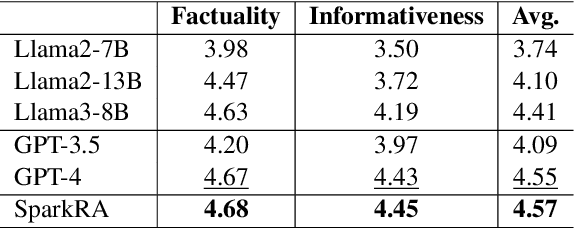

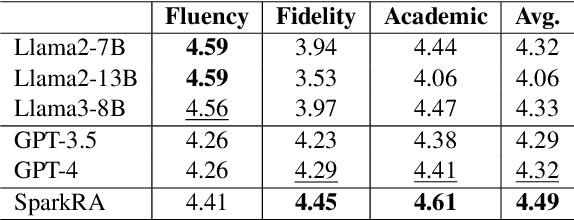
Abstract:Large language models (LLMs) have shown remarkable achievements across various language tasks.To enhance the performance of LLMs in scientific literature services, we developed the scientific literature LLM (SciLit-LLM) through pre-training and supervised fine-tuning on scientific literature, building upon the iFLYTEK Spark LLM. Furthermore, we present a knowledge service system Spark Research Assistant (SparkRA) based on our SciLit-LLM. SparkRA is accessible online and provides three primary functions: literature investigation, paper reading, and academic writing. As of July 30, 2024, SparkRA has garnered over 50,000 registered users, with a total usage count exceeding 1.3 million.
LM-Combiner: A Contextual Rewriting Model for Chinese Grammatical Error Correction
Mar 26, 2024Abstract:Over-correction is a critical problem in Chinese grammatical error correction (CGEC) task. Recent work using model ensemble methods based on voting can effectively mitigate over-correction and improve the precision of the GEC system. However, these methods still require the output of several GEC systems and inevitably lead to reduced error recall. In this light, we propose the LM-Combiner, a rewriting model that can directly modify the over-correction of GEC system outputs without a model ensemble. Specifically, we train the model on an over-correction dataset constructed through the proposed K-fold cross inference method, which allows it to directly generate filtered sentences by combining the original and the over-corrected text. In the inference stage, we directly take the original sentences and the output results of other systems as input and then obtain the filtered sentences through LM-Combiner. Experiments on the FCGEC dataset show that our proposed method effectively alleviates the over-correction of the original system (+18.2 Precision) while ensuring the error recall remains unchanged. Besides, we find that LM-Combiner still has a good rewriting performance even with small parameters and few training data, and thus can cost-effectively mitigate the over-correction of black-box GEC systems (e.g., ChatGPT).
CSED: A Chinese Semantic Error Diagnosis Corpus
May 09, 2023Abstract:Recently, much Chinese text error correction work has focused on Chinese Spelling Check (CSC) and Chinese Grammatical Error Diagnosis (CGED). In contrast, little attention has been paid to the complicated problem of Chinese Semantic Error Diagnosis (CSED), which lacks relevant datasets. The study of semantic errors is important because they are very common and may lead to syntactic irregularities or even problems of comprehension. To investigate this, we build the CSED corpus, which includes two datasets. The one is for the CSED-Recognition (CSED-R) task. The other is for the CSED-Correction (CSED-C) task. Our annotation guarantees high-quality data through quality assurance mechanisms. Our experiments show that powerful pre-trained models perform poorly on this corpus. We also find that the CSED task is challenging, as evidenced by the fact that even humans receive a low score. This paper proposes syntax-aware models to specifically adapt to the CSED task. The experimental results show that the introduction of the syntax-aware approach is meaningful.
Overview of CTC 2021: Chinese Text Correction for Native Speakers
Aug 11, 2022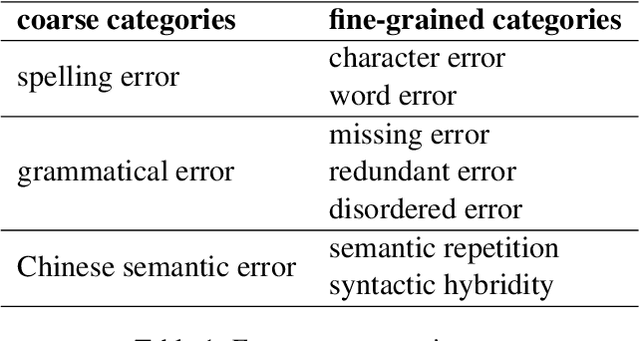
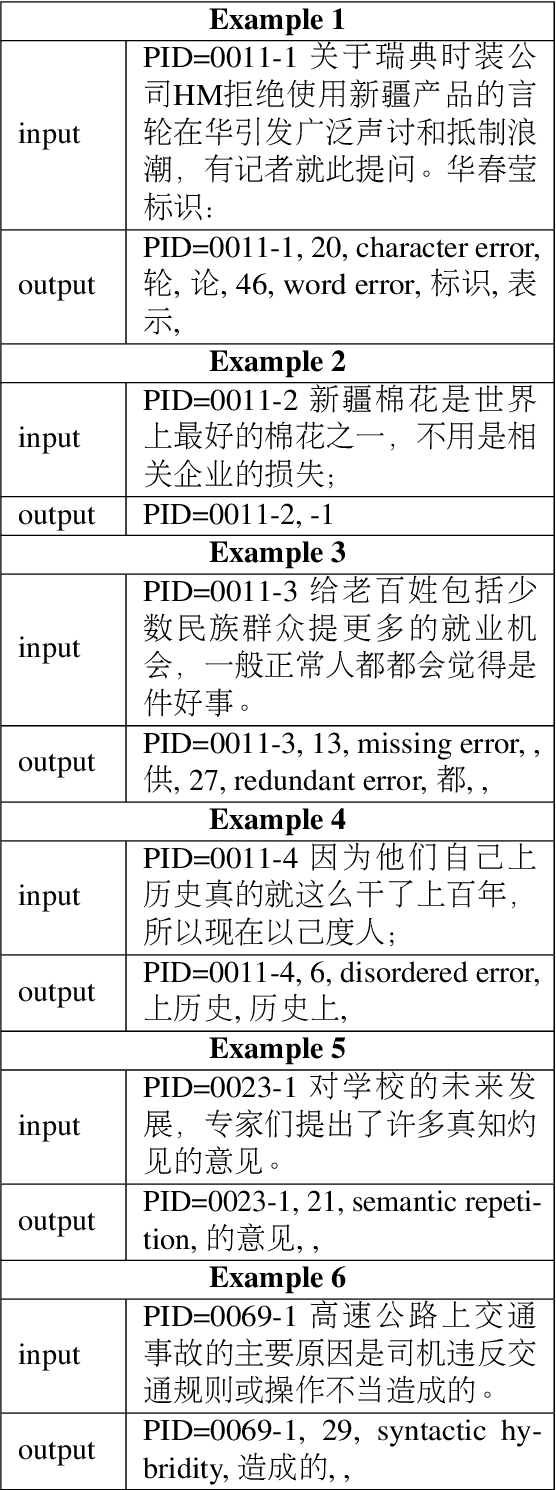
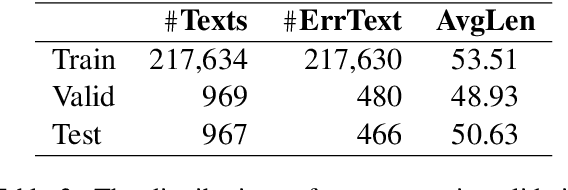

Abstract:In this paper, we present an overview of the CTC 2021, a Chinese text correction task for native speakers. We give detailed descriptions of the task definition and the data for training as well as evaluation. We also summarize the approaches investigated by the participants of this task. We hope the data sets collected and annotated for this task can facilitate and expedite future development in this research area. Therefore, the pseudo training data, gold standards validation data, and entire leaderboard is publicly available online at https://destwang.github.io/CTC2021-explorer/.
Improving Pre-trained Language Models with Syntactic Dependency Prediction Task for Chinese Semantic Error Recognition
Apr 15, 2022



Abstract:Existing Chinese text error detection mainly focuses on spelling and simple grammatical errors. These errors have been studied extensively and are relatively simple for humans. On the contrary, Chinese semantic errors are understudied and more complex that humans cannot easily recognize. The task of this paper is Chinese Semantic Error Recognition (CSER), a binary classification task to determine whether a sentence contains semantic errors. The current research has no effective method to solve this task. In this paper, we inherit the model structure of BERT and design several syntax-related pre-training tasks so that the model can learn syntactic knowledge. Our pre-training tasks consider both the directionality of the dependency structure and the diversity of the dependency relationship. Due to the lack of a published dataset for CSER, we build a high-quality dataset for CSER for the first time named Corpus of Chinese Linguistic Semantic Acceptability (CoCLSA). The experimental results on the CoCLSA show that our methods outperform universal pre-trained models and syntax-infused models.
 Add to Chrome
Add to Chrome Add to Firefox
Add to Firefox Add to Edge
Add to Edge